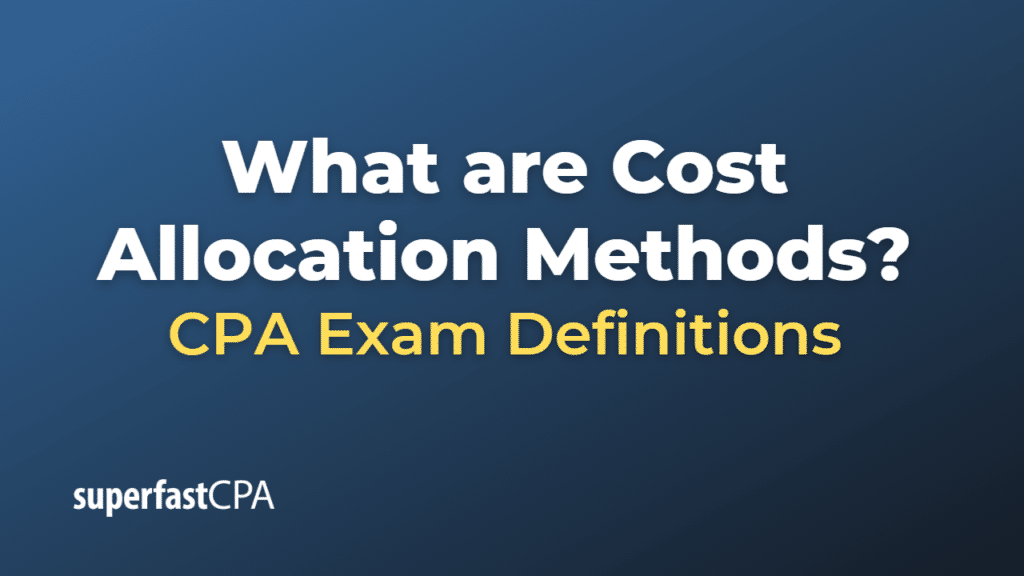Cost Allocation Methods
Cost allocation methods are the techniques used to assign indirect costs (also known as overhead or shared costs) to different cost objects, such as products, services, departments, or projects, in a systematic and rational manner. Since indirect costs cannot be directly traced to a specific cost object or are not economically feasible to trace directly, organizations use cost allocation methods to distribute these costs and better understand the full cost of their products or services. Some common cost allocation methods include:
- Direct allocation method (Single-stage allocation): This method allocates each indirect cost item directly to the cost objects based on a single allocation base, such as direct labor hours, machine hours, or square footage. The allocation base should have a logical relationship with the indirect costs being allocated.
- Step-down method (Sequential allocation): This method allocates indirect costs sequentially, starting with the department or cost center that provides the highest level of support to other departments, and continuing in a hierarchical manner until all costs have been allocated. The step-down method recognizes the interdepartmental services provided but does not account for reciprocal services between departments.
- Reciprocal allocation method (Simultaneous allocation): This method accounts for the mutual support and interdependencies between departments by using a system of simultaneous equations to allocate indirect costs. The reciprocal allocation method is more complex but provides a more accurate representation of the true cost relationships between departments.
- Activity-based costing (ABC): This advanced method allocates indirect costs based on the activities that drive the costs, rather than merely distributing costs based on a single allocation base. ABC identifies cost drivers or cost pools and assigns costs to cost objects based on their consumption of the activities, providing a more accurate representation of the resources consumed by different cost objects.
Each cost allocation method has its advantages and drawbacks, and the choice of method depends on the nature of the organization’s operations, the level of detail required for cost analysis, and the desired accuracy of cost allocations. The chosen method should reflect the cause-and-effect relationship between the cost objects and the indirect costs, and provide useful information for management decision-making, such as pricing, resource allocation, and performance evaluation.
Example of Cost Allocation Methods
Let’s consider an example of different cost allocation methods used by a printing company called “PrintPro.”
PrintPro offers two main services: large-scale commercial printing and small-scale digital printing. The company incurs various indirect costs, such as rent, utilities, equipment maintenance, and administrative expenses, which cannot be traced directly to each service. To allocate these indirect costs to the services, PrintPro can use different cost allocation methods:
- Direct allocation method:
Suppose PrintPro chooses machine hours as the allocation base for its indirect costs. The company first calculates the total machine hours spent on commercial printing and digital printing during the month. Let’s say the company used 800 machine hours for commercial printing and 200 machine hours for digital printing, totaling 1,000 machine hours.
If the total indirect costs for the month are $10,000, the allocation rate per machine hour is:
\(\text{Allocation Rate} = \frac{\text{Total Indirect Costs}}{\text{Total Machine Hours}} \)
\(\text{Allocation Rate} = \frac{\$10,000}{\text{1,000 hours}} = \text{\$10 per hour}\)
Then, PrintPro allocates the indirect costs to the services using the allocation rate and the machine hours spent on each service:
- Commercial printing: 800 hours × $10 per hour = $8,000
- Digital printing: 200 hours × $10 per hour = $2,000
- Activity-based costing (ABC):
Instead of using a single allocation base, PrintPro could implement activity-based costing to allocate its indirect costs based on the activities that drive the costs. To do this, the company identifies cost drivers or cost pools, such as equipment maintenance, administrative support, and energy consumption.
For example, let’s say PrintPro determines the following cost allocations for its total indirect costs:
- Equipment maintenance: $4,000 (allocated based on machine hours)
- Administrative support: $4,000 (allocated based on the number of jobs)
- Energy consumption: $2,000 (allocated based on square footage)
PrintPro then allocates each cost pool to the services based on their consumption of the activities:
- Commercial printing: $3,200 (equipment maintenance) + $3,200 (administrative support) + $1,600 (energy consumption) = $8,000
- Digital printing: $800 (equipment maintenance) + $800 (administrative support) + $400 (energy consumption) = $2,000
Although the total allocated costs are the same in both examples, the allocation using activity-based costing provides a more detailed and accurate representation of the resources consumed by each service. This can help PrintPro make more informed decisions about pricing, resource allocation, and performance evaluation.
In summary, the choice of cost allocation method can significantly impact the allocated costs and the resulting insights. Organizations should carefully select an appropriate allocation method that best represents the cause-and-effect relationship between the cost objects and the indirect costs, and provides useful information for management decision-making.













